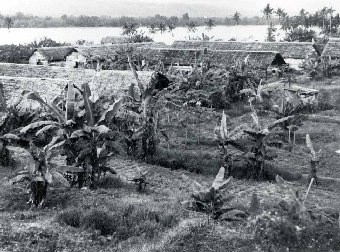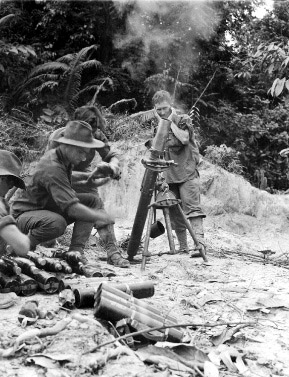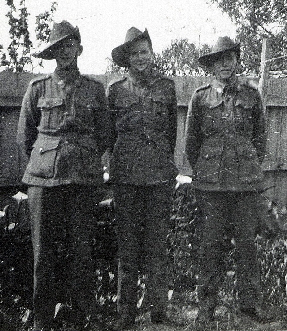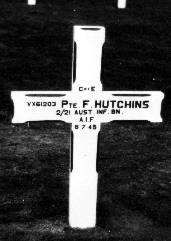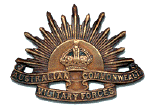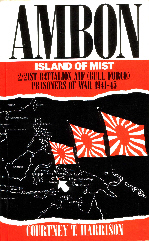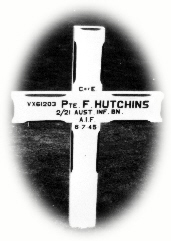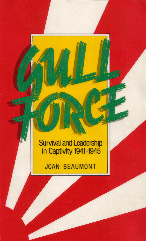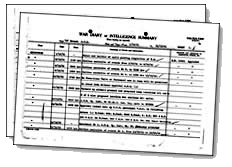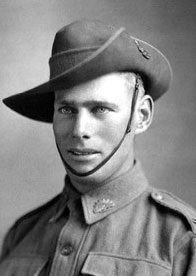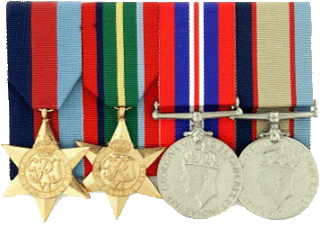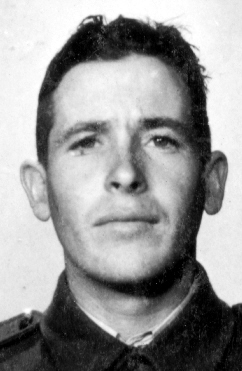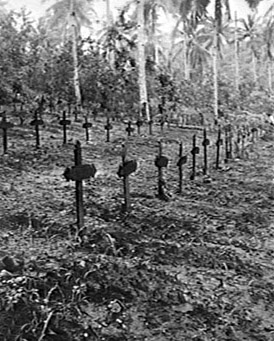The Japanese attack on Ambon, January–February 1942.
The Japanese landed on the island of Ambon on 30 January 1942. After just four days of bitter fighting the under- equipped and poorly prepared Australian and Dutch forces on the island surrendered.
The Australian battalion group of about 1100 men known as 'Gull Force' had arrived in Ambon on 17 December 1941 after a three-day trip from Darwin. The group comprised the 2/21st Battalion, which was part of the 23rd Brigade, 8th Australian Division, together with anti-tank, engineer, medical and other detachments. Their task was to join Netherlands East Indies troops - about 2500 men - to help defend the Bay of Ambon and two airfields at Laha and Liang. The Dutch commander, Lieutenant-Colonel J R L Kapitz, was senior to the Australian commander, Lieutenant- Colonel L N Roach, and took control of both forces, dispersing them into two groups. One group was sent to defend the airfield at Laha on the west side of Ambon Bay and the others were deployed to the east of the bay, south of the town of Ambon. Both the Australian and the Dutch forces were inadequately prepared and under-equipped. Lieutenant-Colonel Roach, aware of the futility of their task, made repeated requests for reinforcements of both men and equipment from Australia, even suggesting that Gull Force should be evacuated from the island if it could not be reinforced. Instead, he was recalled to Australia and Lieutenant-Colonel John Scott, a 53-year-old Army Headquarters staff officer from Melbourne, replaced Roach as commanding officer of Gull Force in the middle of January.
The first Japanese air attack on Ambon was on 6 January and by 24 January the Japanese were less than 1000 kilometres from the island. The last of the Allied aircraft were withdrawn on 30 January.
The Japanese landed three battalions on Ambon during the night of 30-31 January. The Australians lost contact with the Dutch who capitulated the next day on 1 February. Scott, the Australian commander, surrendered two days later on 3 February. Some small groups of men escaped and made their way back to Australia but almost 800 surviving Australians became prisoners of war. The Australians together with about 300 Dutch prisoners of war were put back into their barracks at Tan Tui, north of Ambon town.
On 25 October 1942, about 500 of the Australian and Dutch prisoners were sent to Hainan, an island in the South China Sea off the coast of mainland China. Led by Lieutenant-Colonel Scott, they left Ambon in the Taiko Maru and arrived in the Bay of Sama on Hainan Island on 4 November. The next day they sailed up the coast to a camp at Bakli Bay.
The Japanese government had recognised Hainan Island's potential and planned to use the POWs to build roads and viaducts in order to develop agriculture and industry on the island. The prisoners were forced to do hard manual labour under difficult and brutal conditions with a completely inadequate diet. By 1945 the survivors were all starving. Worse still, Scott was an unpopular senior officer who was unable to command the respect of his troops. His unpopularity increased when he organised Japanese rather than Australian discipline for men who violated Australian army regulations.
Early in 1944, 40 of the Australians were sent to work at the Japanese garrison at Hoban, north of Bakli Bay on Hainan. While out on a work party one morning, they were fired on by Chinese guerrillas, some of several thousand nationalist and communist guerillas still operating against the Japanese on the island. Nine Australian POWs were killed, three were wounded and ten others were captured by the guerillas but were never recovered.
At the end of August 1945, Americans liberated the POWs from Hainan. On Ambon the surviving Australian POWs waited another four weeks to be rescued by the Royal Australian Navy corvettes, HMAS Cootamundra, Glenelg, Latrobe and Junee. The very high (over 75%) death rate on Ambon had been exacerbated when an American bomber dropped six bombs on the Japanese bomb dump right next to the Tan Tui POW camp. The dump ignited and exploded, killing six Australian officers, including the doctor, four other ranks and 27 Dutch women and children. A number of Dutch and Australian casualties died later.
After the Japanese surrender it was discovered that about 300 servicemen who had surrendered at Laha airfield had been killed in four separate massacres between 6 and 20 February 1942. Not one had survived. The prisoners on Ambon and Hainan were subjected to some of the most brutal treatment experienced by POWs anywhere during World War II. Over three-quarters of the Australian prisoners there died in captivity.
Tan Tui Barracks: on the shores of Ambon Bay, where the Australians were billeted with the Dutch and also where the Japanese kept them as POWs.
Extract from Island of Mist: writen by p.o.w survivor, Courtney Harrison
Page 133: Also during the black and tragic month of July 1945, a party of of prisoners were building a new kitchen, some distance from the road at Lateri. Pte F.Hutchins, although very weak and suffering from several bouts of maleria, was ordered to join a working party. Ike Asor began to punish him because of his inability to do much work. He received several beatings, the last beeing with a "three star" iron fence picket. He was knocked to the ground where he was given further punishment. Ike Asor left him unconscious on the ground from where one of his mates later carried him to the truck. He remaind unconcious, and died in the prison camp the following morning. Savage beating had become almost a daily happening: the prisoners expected them at any time, and could do nothing to prevent them.



